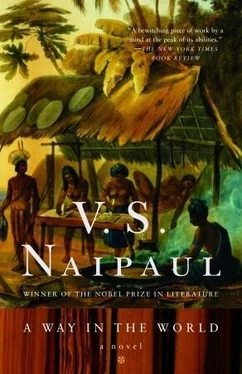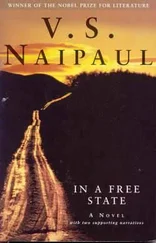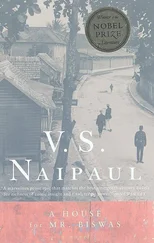Because I had written about it, because for many months Venezuela had existed for me as an imaginary country, created in my mind from the documents I read in London, I felt I had a claim on it. Over a number of journeys I began to think of Venezuela as a kind of restored homeland.
I went on week-long drives along the coast and across the llanos. On my second or third journey I went in an open boat on the Orinoco at a point near the estuary. This landscape had existed for so long in my imagination that even now, when I was seeing it for the first time, it seemed to have a half-imagined, formal quality. The river was wide, full, without turbulence. The banks were worn and denuded: no forest. It was the rainy season. The sky was grey and dark grey, with many layers of cloud, but there was almost a dazzle on the water because of the openness. The river surface (though muddy close to, and oily near the bank) was as grey as the sky, and smooth.
The air was heavy: more rain was going to come. It came sooner than I thought — with a roar, and with a noticeable river swell. Big drops spattered on the water as though on concrete, and the boatman turned back to the bank.
It would have been like the rain, constant violent bursts alternating with damp heat, that tormented Raleigh when he was on the river in 1595. In the documents of the region, he is the first man to write in a modern way — or in a way that brings him close to us — of the many small physical discomforts of this kind of exploration. Spaniards before Raleigh had made journeys twenty times as hard on this river, but in their matter-of-fact accounts, plain to the point of being abstract, physical sensation is missing; landscape is missing. The endurance of these earlier men goes with a narrower way of seeing and feeling.
Not far away from here was an abandoned oil camp. It was like a little ghost town. The bush that some years before had been cut down and regulated was now growing fast again (with here and there a vigorous flower shrub from the settlement) over half-stripped derricks, oil pipes, roofless wooden barracks and roofless concrete-pillared bungalows. Concrete-and-metal bases, and a concentrated mess of old oil, dulled to sepia, showed where the pumps had been. For years, while there had been oil to extract, the big metal arms or shoulders of those pumps would have done their measured, creaking see-saw, night and day, with a plunging, sighing sound at the end of each movement.
Oil had turned out to be the true gold of the region. In the beginning, in the 1920s and 1930s, many people from Trinidad were recruited to work as labourers and artisans and clerks in the Venezuelan oilfields. I don’t know whether this was because Venezuelans simply didn’t want to work in camps in the bush; or whether, after a full century of destructive civil wars, they were without the skills; or whether — as in the Trinidad oilfields, or, earlier in the century, in the building of the Panama Canal — the contracting companies preferred to deal with an immigrant workforce that it could more easily control. But Trinidadians were recruited, and in the oil camps of Venezuela (even with their colonial atmosphere) many of these Trinidadians got their first taste of freedom and money, their first glimpse of possibility.
Until this time Venezuela had a bad reputation in Trinidad, as a South American country of war and poverty, lawlessness, uncertainty, overnight revolutions, dictatorships and sadism. Refugees were constantly coming over; the British laws of the colony offered political asylum. Now, with the oil, Venezuela became a country of opportunity. That was how it was thought of in the 1940s, when I was growing up. But by then Trinidadians were not recruited to work in Venezuela. Venezuela was looking to Europe for its immigrants; there were immigration laws to keep Trinidadians out.
Still, they went. They went illegally. As a boy I used to hear of people going over in this way. With my Port of Spain ideas of our small-scale colonial geography — in which the Gulf of Paria was little more than what I could see of it from the city — I used to think that the people going over illegally would have crossed the few miles to Venezuela at the north of the Gulf, just to the west of Port of Spain. I imagined them getting into their rowing boats at dusk or at night and drifting with the strong currents to the Venezuelan shore.
That was fantasy. But I never asked how the crossing was made, and it was only now, half a life later, and long after I had written my book, and after my own Venezuelan travel, that I began to see that the illegal-immigrant way to Venezuela would have been the old aboriginal way, which in the late sixteenth century became the way used by explorers and traders: down to the far south of the Gulf, and then up the intricate channels of the immense Orinoco estuary — never easy to police.
One afternoon, not long after my short adventure on the Orinoco in an open boat, I came to an estuary town. It had been raining; the main street was sodden, with water in puddles, as though river water had risen up through the earth itself; the air was full of moisture. “The drowned lands of the Orinoco”—the words of an old document came to me. Behind the damp concrete fences flower plants and shrubs and small trees I had known in Trinidad made little jungles around the low houses.
Here and there along this street there came, unexpectedly, through all the damp, the smell of a heavy meat curry. Indians from Trinidad lived here; they were an important part of the local population.
Once aboriginal Indians were masters of these waters. They no longer existed; and that knowledge of currents and tides had passed to their successors. On the south-westernmost point of the long Trinidad peninsula that almost ran into the river estuary there had been an aboriginal port or anchoring place called Curiapan. Curiapan was known to the early Spaniards, and known to Raleigh and others. There was still a fishing village there. But Curiapan no longer existed as a name; the village had a Spanish name, Cedros, the Cedars. Many of the fishermen of Cedros were Asian Indians, descendants of agricultural people from the Gangetic Plain. In less than a hundred years the geography of their new home had remade these Asian Indian people of Cedros, touched them with old aboriginal aptitudes, and given them sea skills which their landlocked ancestors had never had.
I had seen from the air the confusion and the great extent of the waters and the drowned lands of the estuary, and had marvelled at everyone who had come there in the old days, without maps. Because — on the ground, as a traveller — I had approached the estuary from the other side of the Gulf, from the interior of a country that for very long had been for me only an imagined place, I had arrived at a way of looking that contained both the fabulous past and the smaller scale of what I had grown up with.
I had grown up with a small-island geography in my head. But the Gulf I had looked out on as a child was far bigger than the island. The Gulf, with its confused currents, between an island and the estuary of a continental river, had always been part of the fabulous New World. Columbus had found salt water and fresh in it, and — thinking himself only between two islands — had never known why. It had other, and now mysterious, names: Golfo de las Ballenas, the Gulf of Whales, and — like a name that goes back to the beginning — Golfo Triste, the Sad Gulf.
Now I could without disturbance fit Raleigh’s 1595 map of the Gulf to what I saw. His map was the wrong way round. South was at the top of the page: it made more sense that way, to a man looking for a way down to the Orinoco. You can look at the map and see what was real and what — from the formality of the shapes: hard in maps absolutely to lie or to invent — he was making up.
Читать дальше












